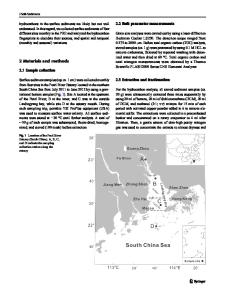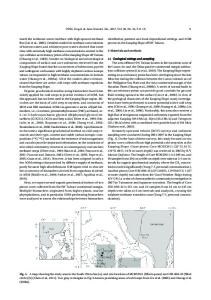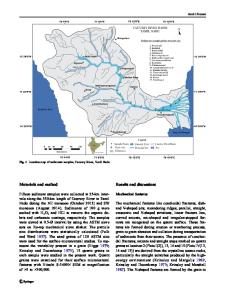Distribution of grain size, clay mineralogy and organic matter of surface sediments from Tirumalairajanar Estuary, Tamil
- PDF / 850,457 Bytes
- 10 Pages / 595.276 x 790.866 pts Page_size
- 36 Downloads / 369 Views
ORIGINAL PAPER
Distribution of grain size, clay mineralogy and organic matter of surface sediments from Tirumalairajanar Estuary, Tamilnadu, east coast of India Senapathi Venkatramanan & Thirunavukkarasu Ramkumar & Irudhayanathan Anithamary
Received: 4 May 2011 / Accepted: 27 September 2011 / Published online: 18 October 2011 # Saudi Society for Geosciences 2011
Abstract The aim of this study is to understand the various sources and factors controlling the abundance and distribution of clay minerals, sand, silt, clay and organic matter of the surface sediments of Tirumalairajanar Estuary in two different seasons. The study was undertaken for two seasons, based on ten selected stations all along the estuary, mouth and freshwater zone. Furthermore, along the estuary region, clay and silt were observed and also at few stations in the upstream end. Organic matters in the sediments appeared to be the main mechanisms for the distribution of clay minerals in estuary indicated that the distributions of clay minerals were comparatively higher during postmonsoon than in premonsoon season. The clay mineral assemblage consists mainly of chlorite, kaolinite, montmorillonite, illite and very scarce gibbsite. The clay from the sediments has been separated and studied for mineral identification using X-ray diffraction analysis. The present study also reveals that sediment texture is one of the main controlling factors for the distribution of organic matter. Keywords Clay minerals . Sand . Silt . Clay . Organic matter . Tirumalairajanar . East coast of India S. Venkatramanan (*) : T. Ramkumar : I. Anithamary Department of Earth Sciences, Annamalai University, Chidambaram, Tamilnadu, India e-mail: [email protected] T. Ramkumar e-mail: [email protected]
Introduction Textural characteristics of estuarine sediments are strongly influenced by several factors, including source area composition of adjacent lands, climate, length and energy of sediment transport and redox conditions in the depositional environments (Bhatia and Cook 1986; Fralick and Kronberg 1997; Dickhudt et al. 2011). Numerous studies have analysed grain size properties which can suggest sources and hydrodynamic conditions of marine sediments (Carranza-Edwards et al. 2005). Moreover, spatial variations in sand, silt and clay ratio can help to determine present estuary environment conditions (Anithamary et al. 2011). The wave activity, the near bed currents, the prevailing climatic conditions, the extreme variations of the discharged load, as well as the grain size and the mineralogical composition of the suspended load, control the grain size distribution in the Thermaikos Gulf (Poulos et al. 2000). The general scarcity of clay-sized sediments in estuary, due to winnowing through the action of waves, tides and currents, contrasts with the huge accumulations of argillaceous deposits in the rest of the oceans. Where they do occur, source mixing during transportation, flocculation and differential settling processes appear to be the main mechanisms for their
Data Loading...











